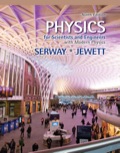
(i)
The current present in the region of space between the plates of the capacitor during the discharging of the R C
(i)
Answer to Problem 34.1QQ
Explanation of Solution
During the discharging of
Conclusion:
Since, the displacement current is represented by the time varying electric flux and there is no conductor between the plates. Thus, option (b) is correct.
As there is no conductor presents between the capacitor plates, there is no conduction current but the displacement current is present. Thus, option (a) is incorrect.
The displacement current is present but the conduction current is not presents between the plates so it is impossible to present both the currents between the plates. Thus, option (c) is incorrect.
As there is displacement current is present between the plates so it is not correct that there is no current of any type. Thus option (d) is incorrect.
(ii)
The field present in the region of space between the plates of the capacitor during the discharging of the R C
(ii)
Answer to Problem 34.1QQ
Explanation of Solution
When a capacitor is fully charged after opening the circuit, after some time it starts to discharge. Due to the discharging of the capacitor there is only electric field is present.
After the some time when the discharging of the capacitor plates take place, the charge particle starts to move from one plate to another plate. This movement of the charge particle creates a magnetic field at the plate. So after discharge of a capacitor plate there is both electric and magnetic fields are present.
Conclusion:
Since, after the discharging of the capacitor plate there is electric field and magnetic field both are present. Thus, option (c) is correct.
As the magnetic field is also present with the electric field then there is no scope that there is no magnetic field. Thus, option (a) is incorrect.
As the electric field is present with the magnetic field then there is no scope that there is no electric field. Thus, option (b) is incorrect.
As the electric field and the magnetic field both are present it is not possible that there is a absence of any field. Thus, option (d) is incorrect.
Want to see more full solutions like this?
Chapter 34 Solutions
EBK PHYSICS FOR SCIENTISTS AND ENGINEER
- 20. Two small conducting spheres are placed on top of insulating pads. The 3.7 × 10-10 C sphere is fixed whie the 3.0 × 107 C sphere, initially at rest, is free to move. The mass of each sphere is 0.09 kg. If the spheres are initially 0.10 m apart, how fast will the sphere be moving when they are 1.5 m apart?arrow_forwardpls help on allarrow_forwardpls help on thesearrow_forward
- pls help on all asked questions kindlyarrow_forwardpls help on all asked questions kindlyarrow_forward19. Mount Everest, Earth's highest mountain above sea level, has a peak of 8849 m above sea level. Assume that sea level defines the height of Earth's surface. (re = 6.38 × 106 m, ME = 5.98 × 1024 kg, G = 6.67 × 10 -11 Nm²/kg²) a. Calculate the strength of Earth's gravitational field at a point at the peak of Mount Everest. b. What is the ratio of the strength of Earth's gravitational field at a point 644416m below the surface of the Earth to a point at the top of Mount Everest? C. A tourist watching the sunrise on top of Mount Everest observes a satellite orbiting Earth at an altitude 3580 km above his position. Determine the speed of the satellite.arrow_forward
- pls help on allarrow_forwardpls help on allarrow_forward6. As the distance between two charges decreases, the magnitude of the electric potential energy of the two-charge system: a) Always increases b) Always decreases c) Increases if the charges have the same sign, decreases if they have the opposite signs d) Increases if the charges have the opposite sign, decreases if they have the same sign 7. To analyze the motion of an elastic collision between two charged particles we use conservation of & a) Energy, Velocity b) Momentum, Force c) Mass, Momentum d) Energy, Momentum e) Kinetic Energy, Potential Energyarrow_forward
 Principles of Physics: A Calculus-Based TextPhysicsISBN:9781133104261Author:Raymond A. Serway, John W. JewettPublisher:Cengage Learning
Principles of Physics: A Calculus-Based TextPhysicsISBN:9781133104261Author:Raymond A. Serway, John W. JewettPublisher:Cengage Learning
 College PhysicsPhysicsISBN:9781938168000Author:Paul Peter Urone, Roger HinrichsPublisher:OpenStax College
College PhysicsPhysicsISBN:9781938168000Author:Paul Peter Urone, Roger HinrichsPublisher:OpenStax College Physics for Scientists and Engineers: Foundations...PhysicsISBN:9781133939146Author:Katz, Debora M.Publisher:Cengage Learning
Physics for Scientists and Engineers: Foundations...PhysicsISBN:9781133939146Author:Katz, Debora M.Publisher:Cengage Learning Glencoe Physics: Principles and Problems, Student...PhysicsISBN:9780078807213Author:Paul W. ZitzewitzPublisher:Glencoe/McGraw-Hill
Glencoe Physics: Principles and Problems, Student...PhysicsISBN:9780078807213Author:Paul W. ZitzewitzPublisher:Glencoe/McGraw-Hill College PhysicsPhysicsISBN:9781305952300Author:Raymond A. Serway, Chris VuillePublisher:Cengage Learning
College PhysicsPhysicsISBN:9781305952300Author:Raymond A. Serway, Chris VuillePublisher:Cengage Learning





